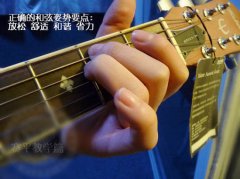There are many approaches to take, and it\'s probably a good idea to use
as many of them as possible.
First, try to learn what the large scale structure of the piece is. Is it
binary? Ternary? Rondo? That way you are basically beginning by cutting
it up into more manageable chunks.
Second, look for phrasing and other types of musical structures.
Try to learn it by ear (can you sing the piece all the way through without
the music or the guitar?). This is easier for people who are more \"aurally\"
orientated (like me).
If you are more \"visual\" try to memorize the page to as great an extent as
you can. The harp prof here gave a lecture about memory & learning
techniques, and said that visual memory really was more stimulated by
looking up (and to the left, I think) so if you can, try placing your music
stand VERY high (for practice & learning) such that you are looking UP at
the music.
I knew many guitarists in Spain who memorized the solfege syllables - they
could sing their pieces from start to finish (mi re mi fa mi re mi...)
Try to memorize the piece starting at the back (This is a tip from David
Russell) - we always go from front to back, often bogging down, so usually,
the farther into a piece we go, the less familiar & comfortable it is. If
you learn the LAST measure, then the next to last measure, etc. you are
setting up a situation where the farther you go, the MORE familiar and
comfortable things are.
This also brings up the issue of learning single measures (apart from
whatever musical context they might have). Jose Tomas used this technique
as a way for his students to learn 30 minutes of *new* repertoire in
1 month: at the beginning, make a learning plan, in which you assing
yourself X measures to learn each day, making sure that every day you
learn some of every piece (instead of working on piece A, then later
starting on piece B, etc.). Learning very short chunks helps you program
your physical movements much better.
This brings up the even more excruciating techniques suggested by Manuel
Barrueco. Make sure you know your right and left hand fingerings so
thoroughly that you can do either separately.
For example, play the piece with the right hand only (i.e. all open
strings, but using the *EXACT* right hand fingerings).
Then, try playing the left hand alone. This is a bit harder, because it
doesn\'t really necessarily function as well without the precision of the
right hand. Barrueco\'s solution is to mis-tune the guitar to some random
tuning (i.e. 6th to F, 5th to Ab, 3rd to G#, 1st to D#)...then play your
piece, concentrating on plainingg the fingering perfectly.
This is an excruciatingly difficult thing to do if you are primarily
an \"aural\" type (I am) - but it\'s good, the totally \"wrong-sounding\"#p#分页标题#e#
nature of this forces you to fight to not be distracted and concentrate
on playing the fingering right.
Do this *very* slowly to practice the fingering without relying on your
附\"反弹吉他\"的翻译:
当回好人,给大致翻译一下:
怎样快速记住一个曲子
有很多办法,最好尽量综合使用
首先是分析曲式,看看是2段体,3段体还是回旋曲,这样就可以把曲子分割成容易对付的几块,
然后看每个段落和乐句,
用耳朵记住整个曲子,你能不能不听录音,不用吉他把整个曲子唱出来?这个方法适合听觉导向的记忆者,
视觉导向的把谱子放在高处往上看更容易记住,
很多西班牙的演奏家能从头到尾把曲子唱出来,3234323。。。。
大卫罗素从后边往前背。。。。
何塞托马斯教学生用1个月记住一个30分钟的曲子,方法是订个计划,把曲子分成小块,每天学一块,顺序任意。。。。
更精确的办法就是象八路爱科一样记住两手的指法,直到可以两手单独运动,
比如,光弹右手,都是空弦,指法要精确。。。
还可以只按左手,八路为了集中精力,把琴弦都给调乱了,这样就不会用右手了,对听觉记忆导向的人这样很难,但是很有效~~~~
很慢的这样练习.

